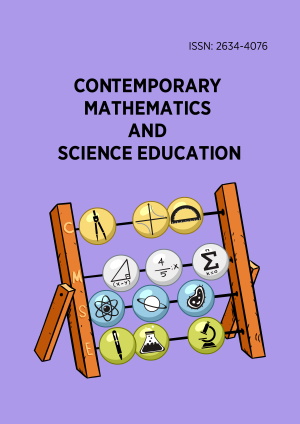Research Article
Using activity method to address students’ problem-solving difficulties in circle geometry
More Detail
1 E.P. Senior High School, Hohoe, GHANA* Corresponding Author
Contemporary Mathematics and Science Education, 4(1), January 2023, ep23016, https://doi.org/10.30935/conmaths/13079
Submitted: 03 October 2022, Published: 14 March 2023
OPEN ACCESS 3386 Views 3922 Downloads
ABSTRACT
This action research sought to address the problem-solving difficulties of students in circle geometry problems using activity method of teaching and learning. The study in investigated students’ difficulties in solving circle geometry problems. It also found out how activity method of teaching and learning helped address the students’ difficulties of solving circle geometry problems. Finally, it established the extent to which the activity method of teaching and learning affected the performance of students in circle geometry. The accessible population was all form two students at Zion College in the Volta Region of Ghana. It numbered 499. The sample was general science 2B students. The sample size was 27 students made up of 10 girls and 17 boys. The instruments for data collection were pre- and post-test. The pre-test was conducted to establish the existence of the difficulties of students in solving circle geometry problems. After establishing the problems, activity method of teaching and learning was used as an intervention to remedy the situation. A post-test was administered to measure the improvement. The data was presented using tables and figures. Inferential statistics was also used to analyze the data. From the analysis, activity method help the students solve complex questions, which demand multiple circle theorems to solve. It was recommended that mathematics teachers should always use activity method of teaching and learning in teaching circle geometry.
CITATION (APA)
Mifetu, R. K. (2023). Using activity method to address students’ problem-solving difficulties in circle geometry. Contemporary Mathematics and Science Education, 4(1), ep23016. https://doi.org/10.30935/conmaths/13079
REFERENCES
- Adu-Gyamfi, R. (2021). Effect of inquiry-based teaching approach on students achievement in circle theorems [Unpublished M.Phil Thesis, University of Education, Winneba].
- Anabah, S. A. (2011). Enhancing students’ achievement in circle theorem through problem-solving approaching [Unpublished MEd thesis]. University of Education, Winneba.
- Anamuah-Mensah, J. (2002). Ghana Educational Reform Committee report: Meeting the challenges of education in the 21st century. Ministry of Education, Ghana.
- Anamuah-Mensah, J., Mereku, D. K., Ghartey, J., & Ampiah (2008). TIMMS (2007) Ghana report. MOE. Accra, Ghana
- Appiah, J. (2011). Advanced instructional strategies in mathematics. Institute for Educational Development and Extension (IEDE), University of Education, Winneba.
- Awanta, E. K. (2011). Research methods in mathematics education. IEDE University of Education, Winneba.
- Awanta, E. K., & Asiedu-Addo, S. K. (2008). Essential statistical techniques in research: For universities, colleges and research institutes. Salt ‘N’ Light Publishers.
- Bishop, G. (1985). Curriculum development: A textbook for students. Macmillan Publishery.
- Chief Examiners Report. (2000). The West African Examination Council, Senior High School Certicate Examination (SSSCE)-school candidates. WAEC.
- Chief Examiners Report. (2005). The West African Examination Council, Senior High School Certicate Examination (SSSCE)-school candidates. WAEC.
- Chief Examiners Report. (2012). The West African Examination Council, West Africa Senior School Certicate Examination (WASSCE)- school candidates. WAEC.
- Churchill, D. (2003). Effective design principles for activity-based learning: The crucial role of 'learning objects' in science and engineering education. http://www.learnerstogether.net/PDF/Effective-Design-Principles.pdf
- Drickey, N. A. (2001). A comparison of virtual and physcial manipulatives in teaching visualization and spatial reasoning to middle school mathematics students [PhD thesis, Utah State University].
- Jones, K. (2002). Issues in the teaching and learning of geometry. In L. Haggarty (Ed.), Aspects of teaching secondary mathematics: Perspectives on practice (pp. 121-139). Routledge. https://doi.org/10.1002/tl.62
- Joppe, M. (2000). The research process. http://www.ryerson.ca/~mjoppe/rp.htm
- Krisnawati, E. (2015). The implementation of teaching writing using discovering learning to the eighth grade students at SMPN 1 grogol in academic year 2014/2015 [Unpublished PhD thesis]. University of Nusantara PGRI Kediri.
- Kusi, H. (2012). Doing qualitative research: A guide for researchers. Accra: Emmpong Press.
- Magno, C., Lajom, J. A., & Regodon, J. R. (2005). Developing a deep approach and attitude to lhrough project-based learning. Learning edge.
- Ministry of Education. (2007). Teaching syllabus for core mathematics (senior high school 13). Accra.
- Ministry of Education. (2010). Teaching syllabus for core mathematics (senior high school 13). Accra.
- National Council of Teachers of Mathematics. (2000). Principles and standard for school’s mathematics. National Council of Teachers of Mathematics.
- Orodho, A. J. (2005). Elements of education and some science research methods. Masola Publisher.

 The articles published in this journal are licensed under the CC-BY Creative Commons Attribution International License.
The articles published in this journal are licensed under the CC-BY Creative Commons Attribution International License.